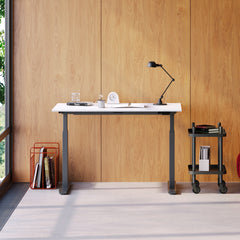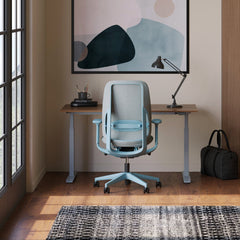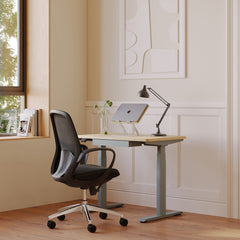Get 10% off your first order
Find the office furniture that’s designed to match your style, comfort, and needs perfectly. Subscribe
Work Anywhere, Thrive Everywhere: The Best Compact Furniture for Hybrid Life

Visit quiz page to see how we makes it easy to create an inspiring workplace

Asking “Should you replace an office chair?” may sound trivial, but the answer carries long-term consequences for your health, productivity, and even your professional image. Office chairs are not just furniture—they are ergonomic tools designed to support posture, circulation, and focus. A poor or worn-out chair quietly drains your energy, contributes to musculoskeletal disorders, and undermines workplace efficiency.
OSHA’s ergonomics guidance emphasizes that poorly designed or deteriorating seating increases the risk of injury and discomfort. For employers, this means higher absenteeism and compensation claims. For individuals, it means fatigue, distraction, and preventable back or neck pain.
Simply put: failing to recognize when it’s time to replace your chair costs more—in productivity, health, and even finances—than investing in a proper replacement.
When people ask, “How often should you replace an office chair?”, the general range is 3–10 years. The wide gap exists because different chair types, usage intensities, and materials all determine how long a chair lasts.

| Chair Type | Lifespan (Years) | Durability Notes |
|---|---|---|
| Budget Chair | 1–3 | Minimal support, short-term solution |
| Task Chair | 3–5 | Affordable but limited in long-term comfort |
| Executive Leather Chair | 5–7 | Durable frame, but leather needs maintenance |
| Ergonomic Mesh Chair | 7–10 | Strong adjustability, breathable material |
Explore long-lasting seating options in the Chairs Collection.
High-density foam, steel or aluminum frames, and premium upholstery extend longevity. Low-quality plastics or cheap fabrics degrade quickly.
A home office worker logging 3–4 hours daily will replace less often than a corporate worker sitting 9–10 hours every day.
Regular cleaning, tightening loose screws, and lubricating casters delay wear and tear significantly.
Knowing how long chairs can last is one thing, but knowing when you must replace them is critical. Here are definitive signals.
A failing chair disrupts spinal alignment and circulation. According to the CDC’s ergonomics guidelines, poor seating is a direct contributor to musculoskeletal disorders. If you’re feeling constant discomfort, the answer to “Should you replace an office chair?” is yes. Consider upgrading to the Ergonomic Novo Chair to restore support.
Discomfort forces micro-adjustments and drains energy. Over time, poor ergonomics compound into lost productivity.
Compressed foam no longer supports hips or circulation, leading to soreness.
Tears, peeling, or cracking not only look unprofessional but also become hygiene concerns.
Instability is both unsafe and distracting. Wobbles and squeaks mean your chair is failing structurally.
Dynamic sitting is crucial; a locked backrest creates stiffness.
If adjustability is gone, ergonomics are compromised. This is when you should replace your chair with something like the Ergonomic Onyx Chair, built for adaptability.
Ask yourself: is your chair helping you work, or holding you back?
Checklist of productivity-killers in a chair:
Frequent fidgeting to get comfortable
Constant posture shifts disrupting focus
Avoiding your desk due to discomfort
If this sounds familiar, you already know the answer to “Should you replace an office chair?”
Yes—usage frequency is one of the most reliable indicators for replacement timelines.
Replacement Timeline: 7–10 years
Watch For: cushion flattening, lumbar support weakening
Replacement Timeline: 5–7 years
Watch For: adjustment fatigue from multiple users, early material wear
Replacement Timeline: 3–5 years
Watch For: mechanical failures, rapid wear in high-stress areas
Recommended Chair: The Muse Chair, built for heavy daily usage and long-term reliability.
Beyond wear and tear, industry standards give a framework for evaluating chair quality and longevity.
The BIFMA Standards test office chairs for durability, stability, and performance. If your chair doesn’t meet them—or has worn past its tested thresholds—you should replace it.
Employers must maintain ergonomic seating that reduces strain. Outdated or failing chairs can trigger compliance issues and liability.
ANSI/BIFMA Certified – confirms structural durability
Greenguard Certified – ensures low emissions for healthier workspaces
Ergonomic Certifications – highlight advanced posture and adjustability features
For an ergonomic and stylish option, the Seashell Chair blends design with compliance-ready support.
Sometimes the answer to “Should you replace an office chair?” is “not yet”—if you’re proactive about maintenance.
Leather: condition regularly to prevent cracks
Fabric: vacuum often to prevent wear from dust
Mesh: gently wipe with mild cleaners to preserve breathability
Lubricate casters for smooth movement
Tighten screws to prevent wobbling
Replace small parts like wheels or arm pads before they damage the frame
Use correct posture to prevent extra stress on mechanisms
Stay within weight capacity limits for safety and durability
Minor fixes make sense for new chairs. But if multiple adjustments fail, cushions sag, or frames weaken, repair costs exceed replacement value.

If you’ve determined the answer to “Should you replace an office chair?” is yes, the next step is selecting the right model.
Adjustable lumbar support
Multi-directional armrests
Seat depth, tilt, and recline functions
Long warranty coverage
Materials tested for heavy use
Reinforced frames for long-term reliability
Chairs aren’t just functional—they shape the feel of your workspace. Look for designs that fit your professional setting while prioritizing support.
The real answer is: all three. Chairs are not static—they either serve you or silently harm you. Health should always be the top reason, but productivity gains and aesthetic upgrades matter too.
When health is compromised: replace immediately.
When productivity declines: treat it as urgent.
When design is outdated: upgrading boosts morale and workplace image.
The next evolution of seating goes beyond when to replace. Future chairs will tell you. Innovations include:
Smart chairs with posture sensors and usage trackers
Adaptive lumbar systems that auto-adjust to your spine
Eco-friendly materials with recyclability built in
By acting early, you don’t just answer the question “Should you replace an office chair?”—you invest in future-ready ergonomics that protect health, support focus, and align with sustainable values.
If your office chair causes back pain, shows visible wear like torn upholstery or wobbly parts, or if its ergonomic features no longer function, then it’s time to replace it. On average, replacement is needed every 3–10 years depending on use and quality.
In high-use environments such as corporate offices or call centers, you should replace an office chair every 3–5 years. Heavy daily use accelerates wear on cushions, tilt mechanisms, and wheels, making early replacement necessary for both health and productivity.
Minor issues like damaged wheels or armrests can often be repaired. But if your chair has structural problems, sagging cushions, or broken recline functions, replacement is more cost-effective and healthier long-term.
Yes, ergonomic chairs generally last longer than budget models because they are built with stronger frames, denser foam, and tested for durability under BIFMA standards
. With proper maintenance, an ergonomic chair can last up to 10 years.
Using a worn-out office chair increases the risk of musculoskeletal issues such as chronic back and neck pain, poor posture, and even circulation problems. According to CDC ergonomics research, poor seating directly contributes to workplace injuries.

Work Anywhere, Thrive Everywhere: The Best Compact Furniture for Hybrid Life

The Hidden Distraction: How Your Desk Might Be Sabotaging Your Focus

From Cubicle to Comfort: The New Era of Hybrid Office Design
Get 10% off your first order
Find the office furniture that’s designed to match your style, comfort, and needs perfectly. Subscribe
Leave a comment